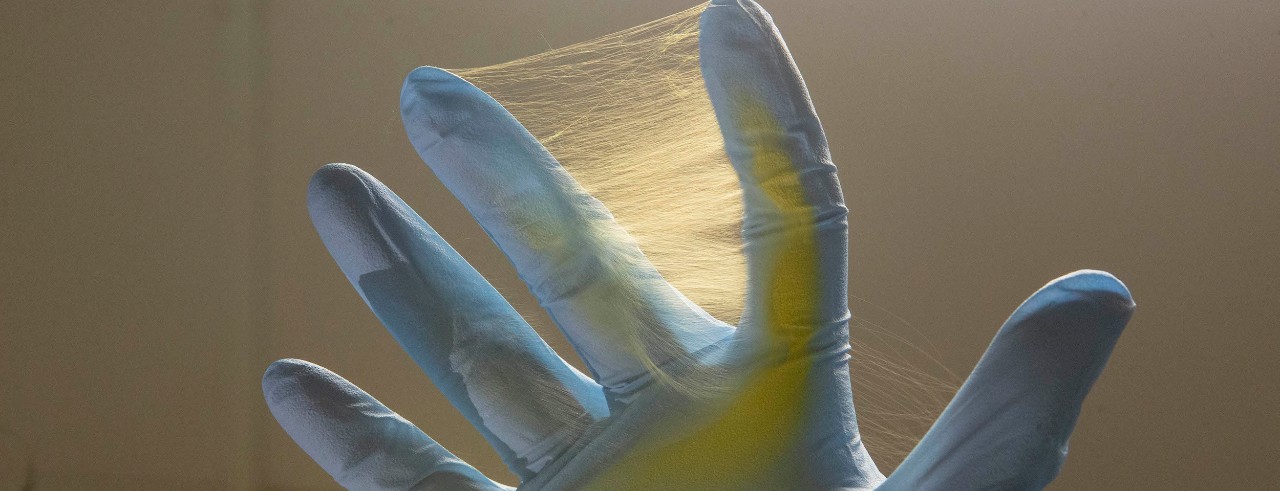
UC engineer spins web of medical innovation
UC’s novel applications of a technology called electrospinning could improve contraceptive products and help patients with brain tumors
When you visit Andrew Steckl’s lab at the University of Cincinnati, you see a nondescript glass box that weaves together different fibers.
He sees endless possibility.
Steckl’s lab is coming up with new applications for a fabrication process called coaxial electrospinning, which combines two or more materials into a fine fiber for use in industry, textiles or even medicine. The machine pumps two or more liquid polymers into a nozzle that drips like a leaky faucet. Once electric voltage is applied, the drip turns into a spiderweb-fine jet composed of a core of one material surrounded by a sheath of another.
“It looks deceptively simple. But the chemistry is the secret sauce,” he said.
This kind of innovation is a key component of the university’s strategic direction, Next Lives Here.
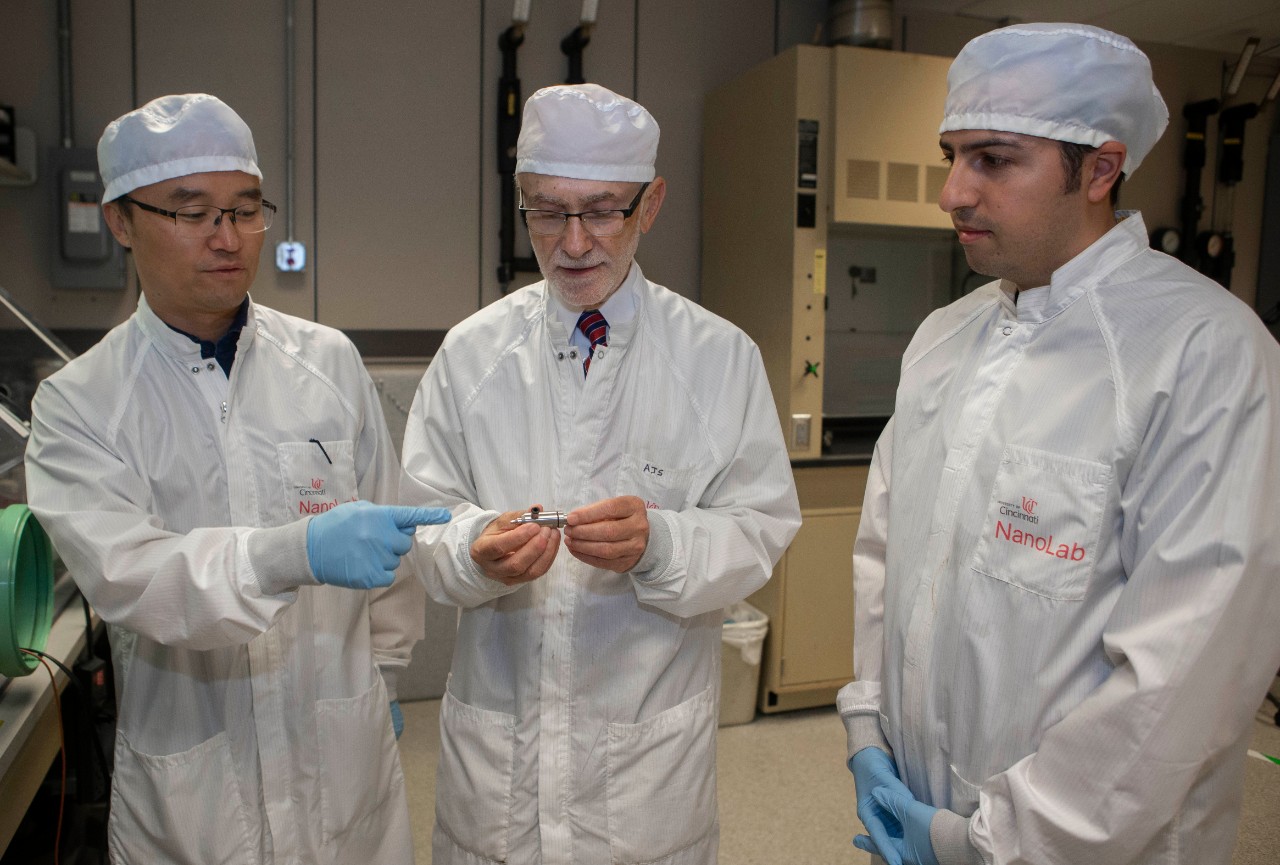
UC engineering professor Andrew Steckl, center, talks with senior research associate Daewoo Han, left, and visiting research fellow Serdar Tort. Photo/Joseph Fuqua II/UC Creative Services
Steckl is an Ohio Eminent Scholar and professor in UC’s College of Engineering and Applied Science. His latest study, published this month on the cover of the journal ChemPlusChem, outlined the many applications of a manufacturing process that combines the amazing properties of one material with the powerful benefits of another.
Electrospinning was invented in 1902 and was first applied to textiles in the 1930s, according to the study. But only now are researchers realizing its full potential, Steckl said. His Nanoelectronics Laboratory has been preoccupied with new combinations of “ingredients” to take advantage of their unique benefits.
“The beauty is you can have combinations of polymers with properties you don’t normally find in nature,” Steckl said.
He has spent much of the past decade investigating the vast potential of electrospinning.
“This is the best thing since sliced bread — not that I like sliced bread,” the marathon runner said.
For example, researchers can combine a stiff core surrounded by soft, flexible or adhesive material. Or they can create a water-resistant shell surrounding a compound that dissolves quickly in water.
“Or you could put drug molecules on the inside for a treatment surrounded by pain-relief molecules on the outside,” he said.
This is the best thing since sliced bread — not that I like sliced bread.
Andrew Steckl, Ohio Eminent Scholar and UC engineering professor
One drawback has been producing enough material for commercial use. But dozens of companies in the United States and around the world are coming up with large-scale production systems for electrospun fibers. Steckl is working with research partners at UC and other research universities to explore the possibilities.
He and former UC College of Pharmacy professor Giovanni Pauletti want to create more effective contraception using coaxial electrospinning. Pauletti now teaches at the St. Louis College of Pharmacy.
The electrospun fiber would be a tampon-like application used to trap and kill sperm. Another version could release anti-infective drugs to prevent sexually transmitted diseases, Pauletti said.
“Our preliminary results are encouraging, enough so that our National Institutes of Health proposal has been approved for a five-year study,” Steckl said.
Steckl said they hope to prove the device is both easier to use and more effective than other sponge-type contraception.
“That’s what the NIH program will confirm,” Steckl said.
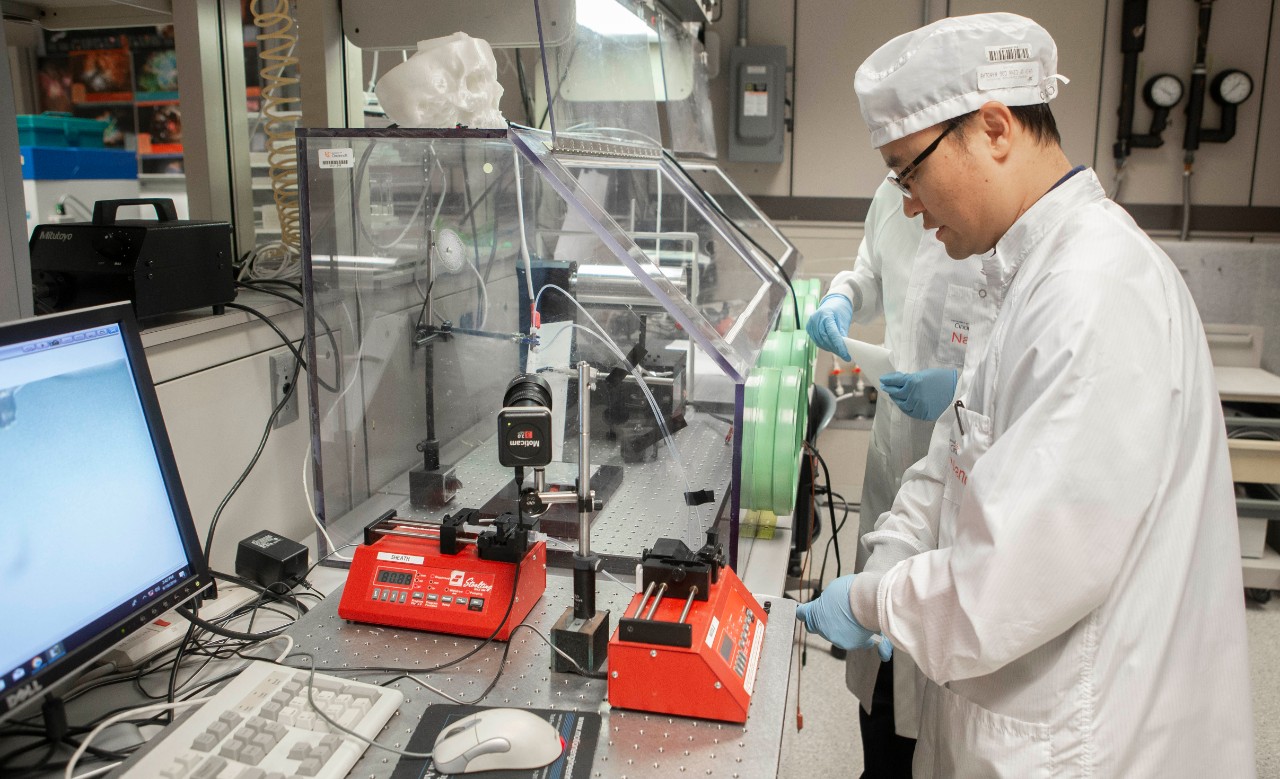
UC senior research associate Daewoo Han creates new fibers from coaxial electrospinning in UC professor Andrew Steckl's Nanoelectronics Laboratory. Photo/Joseph Fuqua II/UC Creative Services
Pauletti said besides technical skills, Steckl has a natural gift to bring together people from different scientific backgrounds for a common research goal.
“One of my greatest pleasures is working across disciplines for the benefit of patients,” Pauletti said. “I love to work with him. He is always open to new ideas.”
Steckl also is working with researchers from Johns Hopkins University to replace traditional chemotherapy with localized treatment of brain tumors called glioblastoma.
“Chemotherapy essentially is whole-body treatment. The treatment has to get through the blood-brain barrier, which means the whole-body dose you get must be much higher,” Steckl said. “This can be dangerous and have toxic side effects.”
Steckl and research partners Dr. Henry Brem and Betty Tyler at Johns Hopkins University are pioneering a treatment in which the glioblastoma lesion is removed and a coaxial electrospun capsule is applied to administer the medicine locally over days or weeks. Brem and Tyler previously developed a treatment wafer called Gliadel in 2003 for glioblastoma.
Tyler, who manages the Hunterian Neurosurgical Laboratory at Johns Hopkins, said implanting the Gliadel wafer loaded with chemotherapy at the site of the removed lesion applies medicine where it’s needed most at a concentration that would be difficult to achieve otherwise without exposing a patient to a toxic dose.
“Our laboratory continues to try new targeted methods of delivery, new delivery formulations and new models to increase the beneficial effects,” she said.
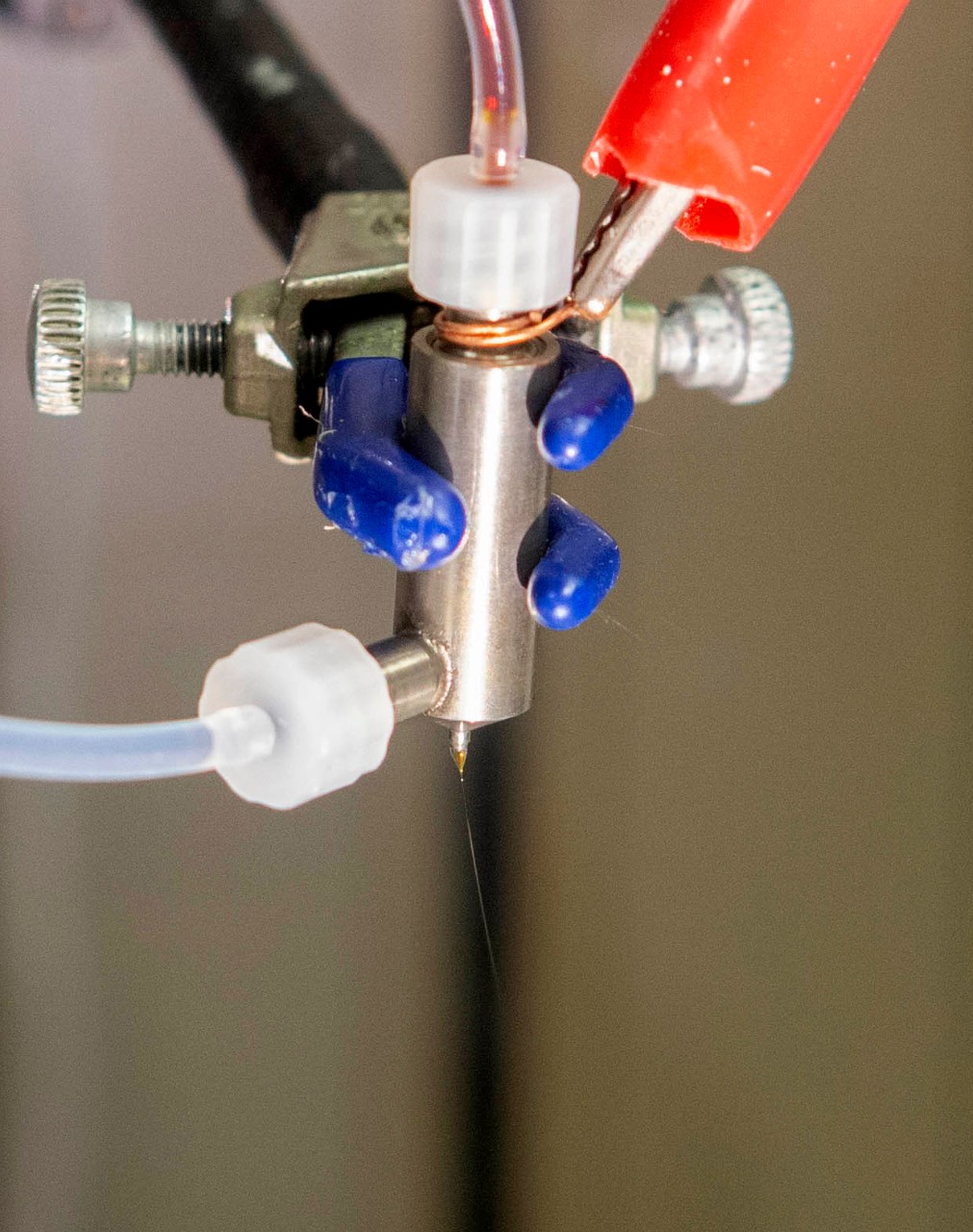
A spiderweb-thin fiber shoots from the nozzle in a jet of liquid during the electrospinning process. Photo/Joseph Fuqua II/UC Creative Services
So far, Steckl said, animal trials have shown that electrospun fibers provide even better results because surgeons can apply different combinations of treatments that deliver medicine for the desired duration.
“Dr. Steckl’s unique electrospun formulation was appealing to us for multiple reasons,” Tyler said. “It has the capability to slowly release its payload, it’s biocompatible and multiple drugs can be loaded and released from it.”
Tyler said they plan to apply electrospinning to other FDA-approved drugs in unique combinations for the treatment of brain tumors.
“Our hope is to deliver these agents using Dr. Steckl’s technology to ultimately increase therapeutic options for patients with brain tumors,” Tyler said.
Steckl said the large surface area and custom properties of the fibers make them an ideal drug-delivery system. For example, patients who have to take drugs multiple times per day for conditions such as Parkinson’s disease might be able to take a single long-acting dose made from electrospun medicines.
“The problem is you may remember your morning dose, but you might forget your afternoon dose,” he said. “Should I take another one? Did I take three today? A single longer-lasting dose is a lot simpler.”
Steckl said researchers are creating electrospun medicines with fibers that only dissolve at a particular acidity in the digestive system. This could delay or extend the release of the active ingredients.
“It’s a pretty clever idea,” he said.
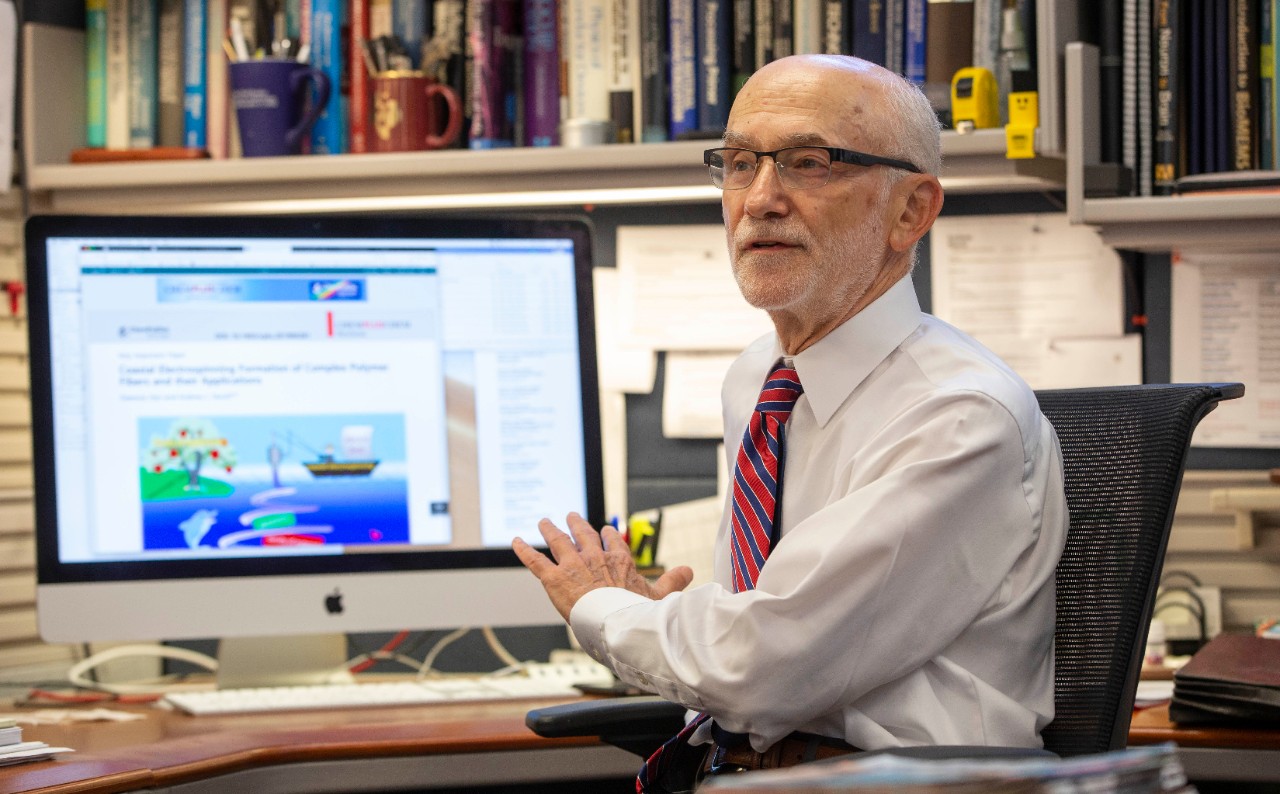
UC engineering professor Andrew Steckl sits at his computer in his office. Steckl has published nearly 500 articles in a variety of journals spanning engineering, physics, chemistry and biology. Photo/Joseph Fuqua II/UC Creative Services
UC senior research associate Daewoo Han, lead author of the ChemPlusChem study, said electrospinning has been used to create versatile nanofibers. Besides medicine, the latest applications include advanced batteries.
“There are unlimited opportunities of collaborations in different disciplines, leading to excellent multidisciplinary research projects,” Han said. “I am very excited about collaborating with experts in other fields and institutes.”
Han said he has enjoyed working in Steckl’s Nanoelectronics Laboratory.
“He is always willing to interact with his students and support them aggressively,” Han said. “He is not only dedicated to current research but also enjoys pursuing new research topics.”
While UC’s research group is not the first to study electrospun fibers, it is producing big results, Steckl said.
“We’ve broadened the field enormously. We’re one of the top research groups in the world working on coaxial electrospinning. It’s been great fun,” he said.
We take our curiosity where it leads us.
Andrew Steckl, UC engineering professor
How does an electrical engineer with no medical background come up with novel solutions in some of medicine’s most complex disciplines such as neurosurgery? Steckl said he has a collaborative spirit and a fearlessness to pursue questions far afield from engineering.
“We take our curiosity where it leads us,” he said.
Steckl has investigated lab-on-a-chip microelectronics, microfluidics and sensors, among other topics in his Nanoelectronics Laboratory. He has co-authored nearly 500 papers that appeared in engineering journals but also in some of the most prestigious journals of physics, chemistry and technology.
And he has always been interested in improving medical devices, he said.
“If you want to solve a problem, frequently it will require more than one discipline,” he said. “So we’ve worked with the UC College of Pharmacy and the UC College of Medicine, the departments of physics, chemistry and biology. Our mindset is: Is this an important research topic?”
Featured image at top: Electrospun fiber looks like spider silk. Photo/Joseph Fuqua II/UC Creative Services
Next Lives Here
The University of Cincinnati is classified as a Research 1 institution by the Carnegie Commission and is ranked in the National Science Foundation's Top-35 public research universities. UC's graduate students and faculty investigate problems and innovate solutions with real-world impact. Next Lives Here.
Become a Bearcat
- Apply online or get more information about undergraduate enrollment by calling 513-556-1100.
- Learn more about UC's many undergraduate and graduate programs.
Related Stories
While working 3 a.m. shifts, UC engineer wowed baseball's Big 12
July 10, 2025
UC College of Engineering and Applied Science graduate Kerrington Cross was named an All-American and Big 12 Player of the Year while co-oping in chemical engineering at L'oreal.
There once was a biologist who talked to spiders …
July 9, 2025
UC biologist and spider expert Nathan Morehouse helped a writing collaboration at Kent University explore our common ground with these eight-legged creatures that fascinate us.
Murals boost Cincinnati’s vitality, community development
July 9, 2025
Murals have a social and economic impact, says a new study by Hyesun Jeong, assistant professor of urban design in UC's College of Design, Architecture, Art, and Planning.
